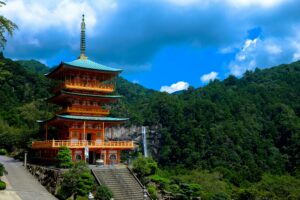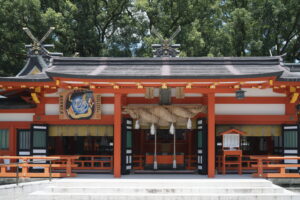What is the Kumano Kodo?
Kumano, located in the southeastern part of the Kii Peninsula, is surrounded by nature and has long been revered as a sacred place where the gods live. Visiting this place gave rise to the belief that by praying for happiness in the afterlife and entrusting one’s thoughts to the gods, one could achieve this. In particular, during the Heian period (794-1185) and the Kamakura period (1185-1333), the Kumano faith spread throughout Japan, and many people made the pilgrimage to Kumano. Emperors, samurai, and commoners alike all made the arduous journey to the sacred Kumano.
This path is known as the “Kumano Kodo”, and it is a pilgrimage route that circles the southern part of the Kii Peninsula. This road connects the three Kumano Shrines (Kumano Hongu Taisha Grand Shrine, Kumano Hayatama Taisha Grand Shrine, and Kumano Nachi Taisha Grand Shrine) and Seiganto-ji Temple on Mount Nachi, and is 1,000km long. In fact, this ancient road spans five prefectures: Wakayama, Mie, Nara, Osaka, and Kyoto.

Inscribed as a UNESCO World Heritage Site

In 2004, Kumano Kodo was inscribed as a UNESCO World Heritage Site under the name “Sacred Sites and Pilgrimage Routes in the Kii Mountain Range” due to its historical and cultural value. Along the route, there are shrines and temples, as well as rich natural scenery, which attracts visitors. One of the main features of Kumano Kodo is its spirit of tolerance, which welcomes everyone regardless of their beliefs, and it attracts many people regardless of their status, gender or religion. This universal value has been recognized, and it is increasing in importance as a World Heritage site.
The Spirit of the Kumano Kodo
One of the reasons why the Kumano Kodo is so attractive is its deep spirituality. Kumano has been known as a holy place of faith since ancient times, and it is a place where diverse faiths have come together.
Primitive Kumano faith
Kumano faith began with the worship of nature deities, such as the Kumano River and Nachi Falls. Later, this faith gradually developed as it was combined with the idea of worshipping ancestral deities. In addition, the fusion of nature worship and Shugendo (a form of ascetic practice that combines nature and sacred power) gave rise to a belief system that combined Shinto and Buddhism.
Syncretism of Shinto and Buddhism(Shinbutsu-Shugo)
The Japanese worship both Shinto gods and Buddhist deities. This is because somewhere in their hearts they are aware that Shinto gods and Buddhist deities are not separate entities, but are one and the same. This spirit of coexistence between Shinto and Buddhism has deep roots in Kumano, which was established during the Nara period.
Jodo faith and Kannon faith
Jodo faith seeks peace after death, while Kannon faith believes in the power of compassion. In Kumano, these two beliefs have merged, and many people have made their way to Kumano.
In this way, Kumano is a place where Shinto, Buddhism, Jodo faith, Shugendo, and Kannon faith all intersect, and it is the origin of the beliefs of the Japanese people today. As a sacred place where nature and faith are in harmony, it has had a profound influence on the spiritual culture of the Japanese people.
A Guide to the Routes of Kumano Kodo
Why not experience the “Road of Prayer” that was trodden by pilgrims of old? In this article, we will introduce three representative courses that take you around the Kumano Sanzan (Kumano Hongu Taisha Grand Shrine, Kumano Nachi Taisha Grand Shrine, Kumano Hayatama Taisha Grand Shrine), which are particularly popular among the Kumano Kodo pilgrimage routes.
1. Hasshimon-oji – Kumano Hongu Taisha Grand Shrine
- Distance: 6.9km
- Walking time: approx. 2.5 hours
This course is characterized by a gentle downhill slope from Hasshimon-Oji to Kumano Hongu Taisha Grand Shrine, and is a popular route with a wide path that is easy to walk on. It is also convenient to access by public transport, and there are rest areas along the way, so you can walk with peace of mind. You can fully enjoy the charm of the Kumano Kodo while walking through the village, where you will see the stone paving of the old road, beautiful terraced rice fields, and tea fields. Along the way, you can visit historical spots such as the “Dōkyū Zenmon Jizo” and “Fushimi Oji”, and you shouldn’t miss the “Sangenjaya Ato” and the observation deck, where you can enjoy the spectacular view.
Goal: Kumano Hongu Taisha Grand Shrine

At this sacred place, you can enjoy the beautiful scenery where history and nature are in harmony, and spend some time relaxing after your visit. We also recommend taking a rest at Ounihara and Zuihoden.
2. Daimonzaka – Kumano Nachi Taisha Grand Shrine and Nachi Falls
- Distance: approx. 2.7km
- Standard walking time: approx. 1 hour
This course takes you up the stone steps of Daimonzaka to Kumano Nachi Taisha Grand Shrine and Nachi Falls. The stone steps of Daimonzaka are short, and the path surrounded by moss-covered stone steps and cedar groves gives you a real feel for the atmosphere of the Kumano Kodo. It is also easy to access from the Katsuura hot spring resort area, and is a pleasant course to walk.
Goal: Kumano Nachi Taisha Grand Shrine and Nachi Falls

Kumano Nachi Taisha Grand Shrine is a place where the gods of Kumano and the gods of waterfalls are enshrined, and you can enjoy the natural beauty of each season and the beautiful vermillion-lacquered shrine buildings. Nachi Falls is one of Japan’s three most famous waterfalls, and its powerful flow is a must-seez
3. Kumano Hayatama Taisha Grand Shrine – Nachi Station
- Distance: 14.8km
- Standard walking time: Approx. 4 hours 03 minutes
- Standard time required: Approx. 6 hours 25 minutes
On the route from Kumano Hayatama Taisha Grand Shrine to Nachi Station, you will start from Kumano Hayatama Taisha Grand Shrine, one of the three Kumano mountains, and enjoy the beautiful scenery and historical spots along the way. On the way, you can enjoy the moss-covered stone pavement and the wonderful view of the Kumano Sea at Koyasan. The old road follows the coast and leads to Kumano Nachi Taisha Grand Shrine.
Starting point: Kumano Hayatama Taisha Grand Shrine

In the precincts, you can feel the mystical energy of the 1,000-year-old nagi tree. Also, the Kumano Jinhokan Museum houses many valuable cultural properties.
The Kumano Kodo is not just an old road, but one that is alive with nature, history and the prayers of the people. As you take each step, you will feel the flow of time connecting the past to the present, and you will have time to face yourself.
Why not free your mind in nature and discover something new on this quiet journey?
By Yune Bando






